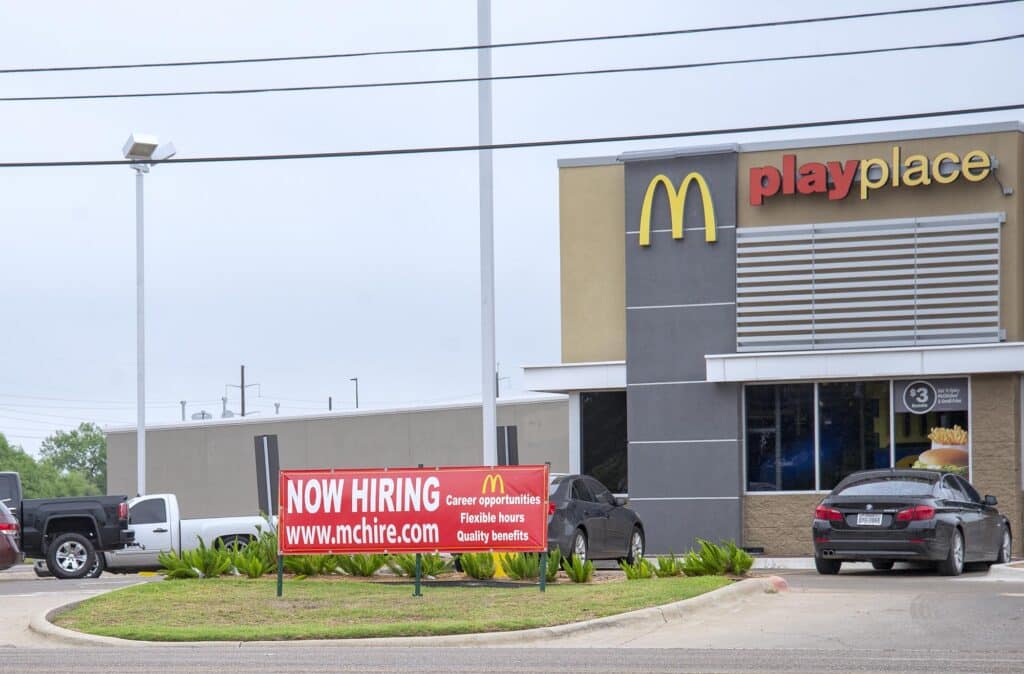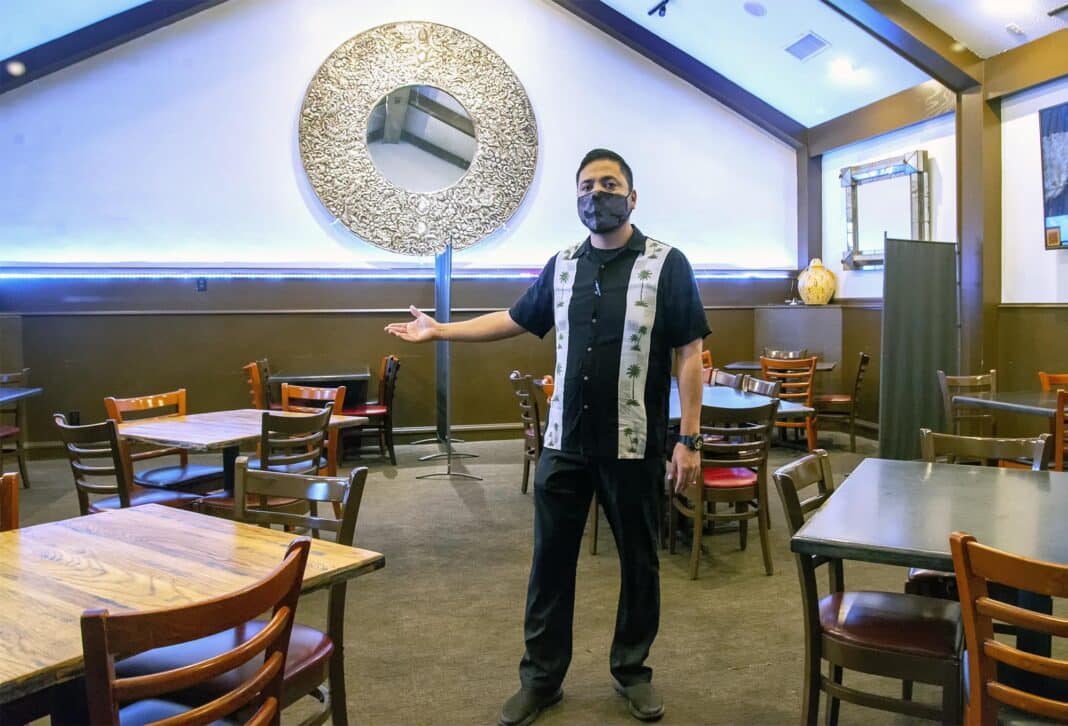HARLINGEN — When Texas’ businesses fully re-opened, Pablo Ochoa was making tortilla chips in his restaurant’s kitchen after he couldn’t find workers to fill his job openings because they were staying home collecting unemployment checks.
Like the nation, the Rio Grande Valley is recovering from the coronavirus pandemic’s economic slowdown but many businesses can’t find workers because they’re still living on record numbers of unemployment checks often paying more than their old wages.
“It happened to us,” Ochoa, general manager of La Playa Mexican Café in Harlingen, said as he recalled his hiring struggle after Gov. Greg Abbott allowed the state’s businesses to re-open at full customer capacity in March.
“A lot of people got unemployment and they didn’t come back,” he said. “Nobody came to apply. People were coming to eat but how can you serve at 100-percent capacity when you have 50 percent of employees? I’m the GM but I was in the kitchen making chips. Thank God we’ve got new employees.”
As the new $1.9 trillion American Rescue Plan Act spurs a boom in public works projects aimed at pumping billions into the economy and jobs into the workforce, experts question whether businesses will find skilled workers to help drive the recovery.
“Now that we’re re-opening, those jobs are coming back on the market — the jobs are there but the workers are still staying at home,” Pat Hobbs, executive director of Cameron Workforce Solutions, said.
“The people have been offered their jobs back so they’re not accepting going back to work,” he said. “We can’t recover until all those businesses are able to open up and those workers get off the couch. If we get them off the couch, we’ll be in good shape.”
By Friday, at least 15 states were cutting off the $300 weekly unemployment checks.
“Usually unemployment runs for 26 weeks,” Hobbs said. “This COVID thing’s been going on well over a year. It’s cost a fortune.”
Record job postings
In March, U.S. employers posted a record 770,000 new jobs — up nearly eight percent, the most on records dating back to December 2000.
Job postings rose in most industries, including restaurants, bars and hotels; manufacturing; construction; and retail.
In a survey, the National Federation of Independent Business found 44 percent of small businesses couldn’t fill jobs — a record high.
Meanwhile, President Joe Biden, whose American Rescue Plan Act included the $300 weekly unemployment checks, is urging the Labor Department to work with states to renew requisites requiring those receiving aid to search for jobs and take offered positions.
“Anyone collecting unemployment, who is offered a suitable job, must take the job or lose their unemployment benefits,” Biden said.
Cameron County unemployment claims
In Cameron County, where 17,139 residents remained jobless in a workforce of 170,857 in March, 3,775 were collecting unemployment checks compared with 2,720 during the same period in 2020, which marked the start of the coronavirus outbreak, according to Cameron Workforce Solutions.
In March, the county’s jobless rate stood at 10 percent compared with 7.7 percent in March 2020.
Across the state, 204,996 Texans continued to receive unemployment benefits which have totaled $49.2 billion since March 2020, when 124,065 had filed claims.
In Texas, the state’s unemployment rate stood at 7.2 percent in March compared with 5.1 percent during the same period last year.
Local restaurant industry claims
In the local restaurant industry, less than a fourth of workers have been living off unemployment checks, Mike Herrera, general manager at Pepe’s Mexican Restaurant, said.
“Twenty percent are taking advantage of the benefits,” he said, adding he hasn’t had trouble putting his employees back on the payroll. “Seventy to 80 percent are hard-working individuals. They got ahead with the help the government gave and they’re still pushing.”

Parents staying home with school children
In the Rio Grande Valley and across the nation, many parents continue to stay home to oversee children taking part in their schools’ remote learning programs aimed at cutting their exposure to the coronavirus.
In Harlingen, 48.5 percent of students remain in the school district’s remote learning program, spokesman Shane Strubhart said.
“There are a lot of people who can’t go back to work because they’ve got kids in school learning from home,” Raudel Garza, executive director of the Harlingen Economic Development Corporation, said.
Recovery projects call for workers
The COVID-19 vaccine is helping open the way for the nation’s economic recovery.
“The vaccine came out and got widely distributed so it’s a little safer environment so the businesses want to get back in action, but the workers don’t want to go back,” Hobbs said.
Last year, the Coronavirus Aid, Relief and Economic Security Act pumped billions into the economy to help keep it afloat.
Now, the American Rescue Plan is aiming to help the nation recover from the slowdown.
“The big difference is the money the feds put out,” Garza said. “That’s keeping the economy going.”
Across the Valley, local governments are taping the cache to launch billions of dollars worth of public works projects.
But officials are questioning whether the Valley’s counties, cities and school districts will find the workers they need to fill the jobs.
As the area’s economy stands poised to boom, many workers are still home collecting unemployment checks amid the region’s shortage of skilled tradesmen.
“They’re going to be building bridges and schools — it all requires workers and if you pay workers a decent wage, it’s good for the economy,” Hobbs said, referring to consumer spending. “A lot of the counties and cities are going to be doing infrastructure public works projects — but there’s no skilled workers.”
Harlingen launching projects
In Harlingen, the American Rescue Plan is expected to pump $22.1 million into city coffers through May 2022 as officials plan to launch water, sewer, drainage and broadband projects.
But officials might not find the skilled workers they need, Mayor Chris Boswell said.
“Local governments are going to start these public works projects,” he said. “I believe we will feel additional impacts on demand. There’ll be an increased demand for tradespeople. It’s going to be hard to fill all the need. We don’t have the skilled workforce we need.”
Road to recovery
Despite concerns surrounding the workforce, the city continues to recover from the pandemic’s economic slowdown.
Throughout the pandemic, the city’s retail sales tax revenue has kept pace with the previous fiscal year’s collection of about $19 million.
“In Harlingen, the recovery is going well and I think it’s going to continue,” Boswell said. “Retail sales tax is bouncing back.”
But it’s the city’s professional job market that’s helping to drive part of the recovery, he said.
“It’s because of the concentration of jobs we have,” Boswell said. “We have a high percentage of the workforce related to health care, government and education jobs.”
Boswell said he’s counting on the city’s businesses to fully re-open soon.
“It takes time to ramp up,” he said.





